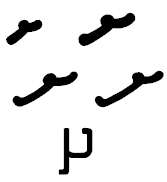Sha viyani
Letter Shaviyani (ށ- formerly Rhaviyani) is the second letter of the Thaana abugaida- the writing system used in Dhivehi language of the Maldives and Minicoy Island.

Phonological significance
The Shaviyani sound ([ʂ]) is unique to the Dhivehi language and is most similar to the cerebral t (ඨ [ʈa]) in Sinhalese. Wilhelm Geiger in his Maldivian Linguistic Studies states:
"The sound is very difficult to describe and to imitate. It varies between r, h and s: is rather soft,; and is, so far as I could observe uttered by putting the tip of the tongue in the highest part of the palate, and letting the breath escape sideways between the teeth".[1]
Anthropological and historic significance
In the earliest work on Maldivian history written by a Maldivian, (the Kitab fi Athaari Meedoo el-Qadimiyyeh by Allama Ahmed Shihabuddine of Meedhoo) Shaviyani is considered a unique characteristic of the language of the first Maldivian settler still reminiscent in the Dhivehi language today. It is said that these first settlers, the Deyvis, came from Kalbanja (possibly Kalinga) in India several centuries before the Kingdom of Malik Aashooq and settled in Isduva island (Isdhoo) of Isduvammathi (Haddhunmathi Atoll). By the time the late-Aryan settlers came to settle the Maldives in 600 B.C., the original language of the Deyvis had been mixed with that of later settlers the Redins and the Kunibeens to form the Deevis language; but the unique Shaviyani sound had survived. The letter was described as that letter pronounced between the letter "r" and "sh". In fact the letter was called rhaviyani until much later.[2]
Linguistic usage
In modern Dhivehi, the letter Shaviyani has two different usage.[3]
- As a consonant in words such as ބޯށި-boaʂi (banana inflorescence), ނާށި-naaʂi (coconut shells), ދޮށި-dhoʂi (fishing rod) and ދިނަށަ-dhinaʂa (an asterism of Delphini).
- Accompanying the diacritic sukun (ށް). It can be at the final position of a word where the end is abrupt and the value [h]. In this case the value stands for the letter that has disappeared but comes back as [ʂ] when the word is conjugated with another word or when used in full. For example, in the word ރަށް-rah (island); but comes back in ރަށެއް-raʂeh (an island), ރަށަކީ-raʂakee (the island is) and ރަށަކުން-raʂakun (from an island).
Other notes
Shaviyani is also the name designated to the administrative division of the Maldives comprising the 51 islands of the Northern Miladhunmadulhu Atoll.
See also
- The Dhivehi language
- The Mahal language
- Dhivehi writing systems
- The Thaana alphabet
- History of the Maldives
- The letter Naviyani
References
- ↑ Wilhelm Geiger (1919), Maldivian Linguistic Studies. Colombo
- ↑ Allama Ahmed Shihabuddine (original work in Arabic, translated to Dhivehi by Dhoondeyri Don Maniku), Kitab fi Athaari Meedoo el-Qadimiyyeh. Male'
- ↑ A Concise Etymological Vocabulary of Dhivehi Language. Hasan A. Maniku. Speedmark. Colombo 2000.